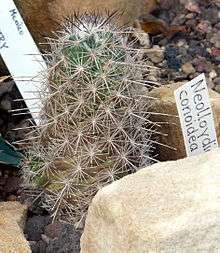Neolloydia
Neolloydia is a genus of cacti. The genus is uniquely found in the dry scrub areas of southern Texas (Big Bend) and the Chihuahua Desert of Northeast Mexico.
| Neolloydia | |
|---|---|
 | |
| N. conoidea | |
| Scientific classification | |
| Kingdom: | |
| (unranked): | |
| (unranked): | |
| (unranked): | Core eudicots |
| Order: | |
| Family: | |
| Subfamily: | |
| Tribe: | |
| Genus: | Neolloydia |
| Species | |
| |
Taxonomy
The genus was first erected by Britton & Rose in 1922 in order to classify three uncomfortable species formerly placed in the genus Mammillaria (N. conoidea, N. ceratites, and N. grandiflora). A fourth species was added in 1923 (N. texensis). But it was not until 1948 that a fifth and final species was added by Backeberg (N. matehualensis).
Since then, Neolloydia has been a dumping ground for species from such diverse genera as Mammillaria, Coryphantha, Escobaria, Echinomastus, Cumarinia, and Thelocactus.
It was not until Glass and Foster (1977)[1] showed that there are very few botanical differences between Turbinicarpus and Gymnocactus that the definition of the genus Neolloydia began to take shape. Their work was followed up by John and Jan Říha (1981) and finally by Anderson in 1986. It now seems that Anderson's work on the Neolloydia complex is the generally accepted view.
Synonymy
The following are considered synonyms of Neolloydia:
- Napina Fric (nom. inval.)
- Pseudosolisia Y.Itô (nom. inval.)
References
- Glass, C. & Foster, R. (1977), "A revision of the genus Turbinicarpus", Cactus and Succulent Journal, 49: 161–176